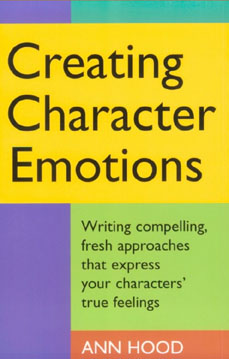
CREATING CHARACTER EMOTIONS by Ann Hood (a book review by L McKenna Donovan) Many of you will recognize Ann Hood currently a professor at New York University. Author of seven novels with Bantam/Doubleday, she has also published short stories and essays in such venues as STORY and Glimmer Train as well as various newspapers and magazines. She has served on the faculties of many universities and writer's conferences. In her book, Creating Character Emotions, Ann Hood points out that in our daily lives we pass through a whole spectrum of emotions, yet in our fiction, we often have trouble moving our characters through these emotions effectively. Her basic philosophy is that "emotions affect every other element of fiction dialogue, action, character development, plot, theme. When written well and convincingly, they lead us to more genuine characters who act and speak and think in a richer way. Emotions lead us to more believable plot twists and turns, enhance dramatic tension, help to illustrate themes. In short, they inform every aspect of our fiction." Working from the premise that fiction is not real life, Ann devotes Part One: Writing About Emotion to the idea that writing the emotions we experience is not the same as writing the emotions of our characters. She explains the differences between these two writing experiences in basic terms, illustrating them with concrete examples. Although her formula seems simplistic, it is an excellent jumping off point for experimenting with your characters' reactions to their fictional situations. One point I find of interest is "The Clich Trap". When we allow our characters to be "green with envy", we are flattening their emotions by providing trite material to our readers. To write that a gentleman's face is "red like a beet" produces a different emotional reaction in the reader than saying "his face looks like a boiled ham." Hood advises us to reach for the second thing that comes to our mind, to use fresh language and to be true to the emotions themselves. Certain emotions require that your character work through stages stages that can take time. An excellent example is grief. If a character experiences the death of a loved one on page 9, then page 10 cannot show that character trotting off to buy an Armani suit. At least not if you expect to keep the reader engaged. Obviously there are permutations on this formula, when a character is influenced by any one or more of a wide variety of psychoses, neuroses, and criminal behavior, but the basic premise is that there are identifiable stages to emotions. In Part Two: The Emotions, Hood lists thirty-six basic emotions. Come on now, how many of us can even list thirty-six emotions? Try it! I struggled to list nineteen. Hood takes each of these emotions, such as ANGER, and gives a brief overview of the emotion itself from a psychological standpoint as well as her personal perceptions. She provides BAD EXAMPLES of how that emotion has been portrayed. Then the following section, GOOD EXAMPLES, provides concrete passages from already published authors. She completes each section on a particular emotion with EXERCISES, which challenge our abilities to understand emotions and evoke emotional images for our readers. Do you want anger? Do you envision a person shouting with a red face? Maybe someone using her fists? Try this good example, quoted from Stanley Elkin's story, "A Poetics for Bullies": I'm Push the bully, and what I hate are new kids and sissies, dumb kids and smart, rich kids, poor kids, kids who wear glasses, talk funny, show off, patrol boys and wise guys and kids who pass pencils and water the plants and cripples, especially cripples. I love nobody loved. Can't you feel the anger underneath that hate? With neither screaming nor flying fists, the anger is real. Interestingly enough, the word angry was never used. Go figure.
© 2001 L McKenna Donovan |